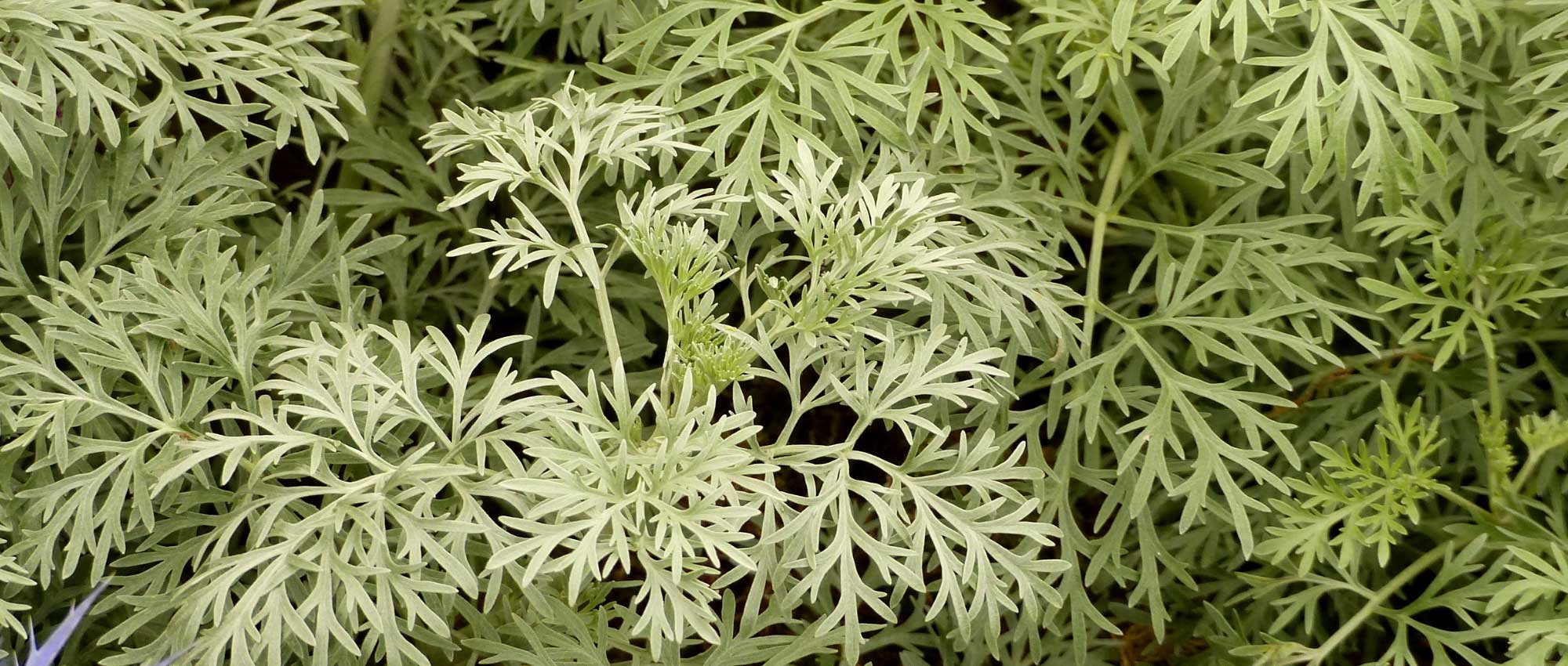
Mugwort, Artemisia: planting, pruning and care
Contents
Mugworts in a nutshell
- Artemisias offer stunning foliage, often silvery and finely divided
- Some have a cushion habit, forming lovely rounded, compact clumps
- Their foliage is aromatic, generally highly fragrant
- They thrive in full sun, in well-drained, rather poor and dry soil
- Preferable to prune them from time to time
A word from our expert
Wormwoods, or Artemisia, are plants valued for their finely cut foliage and attractive silvery tones. They are perennial plants or shrubs, sometimes annuals, such as Artemisia annua. Foliage is generally aromatic and fragrant, and can be cut very finely, lace-like. Flowers, by contrast, are less interesting and rather undistinguished. Wormwoods take various forms: some grow in upright, tufted, shrubby clumps, others are very spreading and low, like Artemisia schmidtiana, forming dense, cushiony mats.
Wormwoods are also medicinal and aromatic plants, containing essential oils within their tissues. Some of these plants are very well known: absinthe (A. absinthium), genepi (A. genipi), aurone or tarragon (A. dracunculus) are all Artemisia. Common mugwort, Artemisia vulgaris, is one of the most used for its medicinal properties. It is also a species that grows wild in France.
They thrive in warm, dry situations. They like full sun and well-drained, rather poor and dry soils. They require little maintenance: no major needs for watering or feeding, but will appreciate being pruned from time to time to maintain a compact habit.
Silvery foliage of wormwoods is ideal for highlighting other flowering displays. It provides a superb backdrop and harmonises very well with flowers in pastel tones — pink, mauve, blue or white. It can fit into a romantic garden, for example with roses and peonies.
Botany
Botanical data
- Latin name Artemisia sp.
- Family Asteraceae
- Common name Mugwort
- Flowering summer, from July to September, but not very decorative
- Height often between 30 cm and 1.50 m
- Sun exposure full sun
- Soil type free-draining, rather poor and dry
- Hardiness variable, but generally fairly good (often around -15 °C)
Mugworts, grouped under Latin name Artemisia, are often perennial or shrubby plants, sometimes annual (such as Artemisia annua). There are about 480 species. They originate mainly from temperate zones of Northern Hemisphere, where they grow in dry, relatively arid habitats. Mugworts generally have very aromatic foliage. Some species are used for their flavours: tarragon (Artemisia dracunculus), genepi (Artemisia genipi), wormwood (Artemisia absinthium)… Artemisia are often very fragrant and have rather bitter taste, which deters herbivores tempted to eat them. These plants also have medicinal properties. Essential oils can be extracted from mugworts by distillation.
In the wild, in France, about twenty species can be found, including Artemisia absinthium (wormwood), Artemisia arborescens, Artemisia genipi (genepi) or Artemisia vulgaris. Overall, Artemisia are fairly hardy. Some species, such as genepi or Artemisia glacialis, are particularly adapted to cold, montane climates: they occur mainly in Alps above 2,000 m altitude.
Artemisia should not be confused with mugwort-leaved ragweed (Ambrosia artemisiifolia), an invasive plant native to North America, which causes severe allergies.
Some species are considered weeds (notably Artemisia vulgaris), yet this plant has medicinal properties and its leaves are edible.
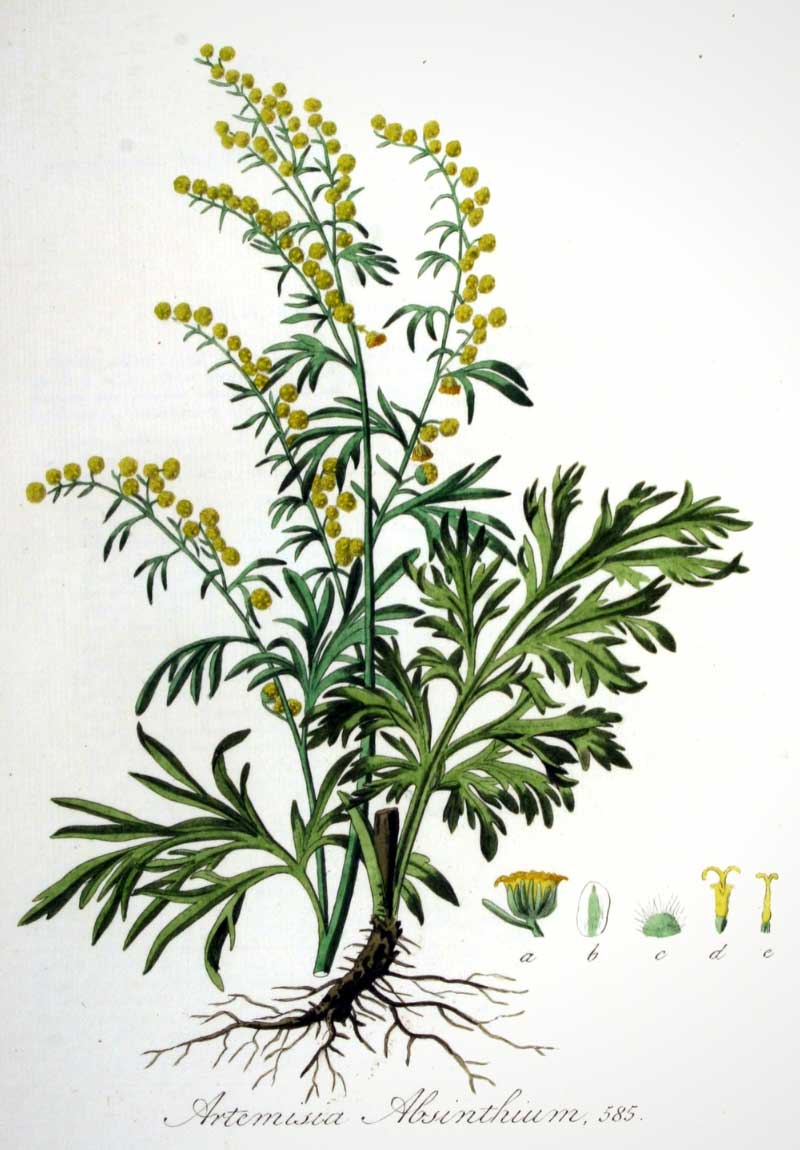
Artemisia absinthium: Botanical illustration
Mugworts belong to large family Asteraceae, like dandelions, sunflowers and oxeyes. Unlike most Asteraceae, often grown for showy flowers, mugworts are mainly ornamental for foliage.
Artemisia owes its name to Greek goddess Artemis, goddess of hunting and chastity, protector of childbirth, associated with moon; a goddess strongly linked to women. Artemisia was probably named so because it is a plant that protects and heals women: it is notably emmenagogue, promoting and regulating menstrual cycle.
Depending on species, height varies greatly: smallest measure between 10 and 30 cm tall (Artemisia schmidtiana, Artemisia stelleriana ‘Boughton Silver’…), while tallest can reach 1.50 m, even 2 m. Some mugworts, like Artemisia schmidtiana, form small rounded, compact clumps. By contrast, Artemisia lactiflora grows in upright clumps and is among tallest species.
Mugworts are prized for superb foliage! Leaves can take varied shapes but are generally deeply divided. Different segments making up leaves are long, thin and narrow. This gives very pretty foliage often resembling lace. Leaf size is variable, often between 5 and 10 cm long (in Artemisia lactiflora, up to 25 cm). Not all varieties have same leaf dissection: those of Artemisia ‘Powis Castle’ are very finely divided, while those of Artemisia ludoviciana are more or less entire.
Leaves of mugworts are alternate, inserted one after another. Depending on species, they can be evergreen or deciduous, persist over winter or disappear.
Mugwort leaves often show lovely silvery tones. Variety ‘Powis Castle’ is remarkable for superb grey, almost bluish foliage, also nicely dissected. Leaves can also be green, more ordinary, as in Artemisia annua. In Artemisia lactiflora ‘Guizhou’, they have a dark, purplish hue. Variety Artemisia ‘Oriental Limelight’ is notable for variegated yellow foliage! Sometimes mugwort leaves are green above and whitish-tomentose beneath. Generally, leaves take prettier, more silvery tones when plant is grown in poor, free-draining soil than in rich, moist soil.
Foliage of Artemisia stelleriana closely resembles that of Dusty Miller, Senecio cineraria. Shape and colour are very similar.
Leaves are often aromatic, very fragrant, which helps deter herbivores. They contain essential oils and are sometimes used for flavouring or medicinal properties. Best examples are tarragon, Artemisia dracunculus, used in cooking, as well as aurone, wormwood and genepi.
Artemisia abrotanum ‘Cola’ has a scent reminiscent of famous cola soda! Leaves can even be used in cooking, added to salads or savoury dishes.

Foliage of mugworts is nicely dissected. Artemisia ‘Powis Castle’, Artemisia schmidtiana ‘Nana’ and Artemisia stelleriana ‘Silver Brocade’
Mugworts flower in summer, from July to September. However, flowering is of little interest. It is not very decorative… except for flowering of Artemisia lactiflora. This species bears large, white panicles, very airy in appearance, somewhat reminiscent of Aruncus dioicus. Artemisia glacialis (glacier genepi) bears bright yellow heads.
In most mugworts, inflorescences are small, fairly inconspicuous, often pale yellow. Flowers are grouped in heads (characteristic of family Asteraceae), placed at stem tips. These heads usually measure less than one centimetre in diameter. They are sometimes gathered in panicles.
Flowers of most Artemisia species are wind-pollinated (anemophily), unlike many Asteraceae that rely on insects to carry pollen from one flower to another… which is perhaps unsurprising, since aromatic foliage of mugworts seems to repel a number of insects!

Flowering of Artemisia absinthium (photo Matt Lavin), Artemisia vulgaris, and large, very airy white panicles of Artemisia lactiflora.
Stems of Artemisia are sometimes slightly reddish or purplish, darker than rest of plant; but this also depends on cultivated varieties.
Some mugworts have rootstocks, enabling gradual spread.
Once flowering is over, Artemisia produce achenes, small dry indehiscent fruits (that do not open at ripeness) each containing a seed. They do not bear an egret, unlike many Asteraceae (such as dandelion, where small egrets allow each seed to fly).
Some Artemisia, notably wormwood and Artemisia annua, have allelopathic effect: they emit chemical compounds that prevent germination or limit growth of other plants nearby. If planting other species close by, better to leave at least one metre distance. Advantage is that weeds will also struggle to grow beside these mugworts.
Read also
Lavender: planting, growing, pruningMain Artemisia varieties
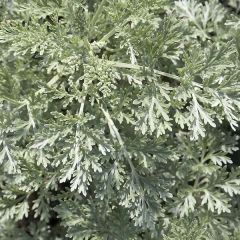
Artemisia arborescens Powis Castle
- Flowering time August, September
- Height at maturity 90 cm
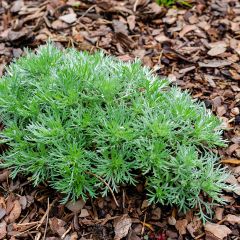
Artemisia schmidtiana Nana
- Flowering time July
- Height at maturity 10 cm
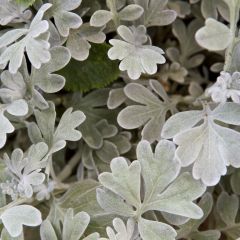
Artemisia stelleriana Boughton Silver
- Flowering time August, September
- Height at maturity 15 cm
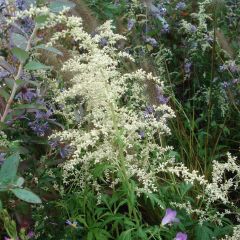
Artemisia lactiflora
- Flowering time July to October
- Height at maturity 1,50 m
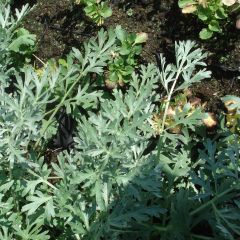
Artemisia absinthium Lambrook Silver
- Flowering time August, September
- Height at maturity 90 cm

Artemisia abrotanum
- Flowering time August to November
- Height at maturity 1 m
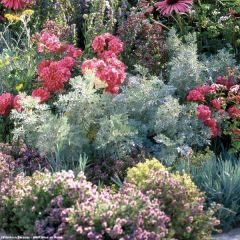
Artemisia arborescens Little Mice
- Flowering time August to October
- Height at maturity 40 cm

Artemisia ludoviciana Valerie Finnis
- Flowering time July to September
- Height at maturity 50 cm
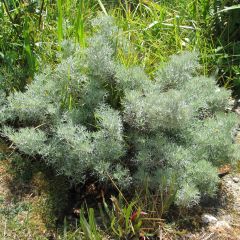
Artemisia alba Canescens
- Flowering time September, October
- Height at maturity 40 cm
Discover other Artemisia
View all →Available in 1 sizes
Available in 2 sizes
Available in 1 sizes
Available in 1 sizes
Available in 1 sizes
Available in 1 sizes
Available in 2 sizes
Available in 1 sizes
Available in 1 sizes
Available in 1 sizes
Planting
Where to plant?
Plant Artemisia preferably in full sun, although most varieties can also tolerate partial shade.
It will thrive in a free-draining, fairly dry soil, except for Artemisia lactiflora, which requires a moist soil. For most species, it is useful to improve drainage by placing a small layer of gravel in the planting hole. Artemisia will have a shorter lifespan if planted in heavy soil that tends to retain water. Likewise, Artemisia do well in poor soils and dislike overly fertile ground. They are not very sensitive to pH, but do show a preference for calcareous soils. Overall, Artemisia are not very demanding plants; they thrive on very little!
Heat, poor soils and drought encourage Artemisia to keep a compact, fairly dense habit and enhance foliage colour, giving a silvery sheen. In shade, or in a rich, cool soil, the plant may develop a much more upright and untidy habit.
Artemisia fit easily into perennial beds, borders, rock gardens, herb or medicinal plant gardens, and in container or planter compositions. With its spreading habit, Artemisia schmidtiana is perfect at the front of a border.
Artemisia lactiflora has different growing requirements from other Artemisia: it needs a rather moist soil, likes fertile ground and partial shade. With its light, free aspect, it will find a place easily in naturalistic gardens.
→ Learn more about growing Artemisia in pots in our advice sheet
When to plant?
We recommend planting Artemisia in spring, from April onwards. Planting is also possible in autumn.
How to plant?
Depending on variety and size, we suggest spacing of between 50 cm and 1 m.
- Dig a planting hole. You can add gravel or coarse sand to improve drainage and water infiltration.
- Remove Artemisia from its pot, lightly loosen the roots by gently teasing the rootball, then place your Artemisia in the planting hole. Its collar should sit just at soil level, not below.
- Backfill by replacing soil around it.
- Firm down with the palm of your hand.
- Water generously.
Continue to water over the weeks following planting. Artemisia need water while they establish and develop their roots. Afterwards, they will manage without it.

Artemisia abrotanum (photo Alice Chodura – Oceancetaceen)
Care
Artemisia tolerate drought quite well. It is generally not necessary to water them (except perhaps during first year). It is also unnecessary to feed them, as Artemisia grow well in poor soils, but you can, however, add some compost in autumn.
You can divide clumps every two or three years to rejuvenate your plants and possibly replant them elsewhere or give some to relatives.
Regarding diseases, some Artemisia can be affected by powdery mildew. It is a fungal disease, caused by tiny fungi, and is recognised by a white powdery coating on the leaves. You can treat by spraying, for example, a sulphur-based solution or a horsetail decoction. The species most susceptible seems to be Artemisia lactiflora. As for pests, beware of black aphids, which sometimes settle on Artemisia and suck sap. If your plant is attacked by these insects, you can spray diluted black soap in water.
Pruning
Pruning Artemisia will help maintain plants with a bushy, balanced habit. Over time, perennial Artemisia sometimes tend to become bare in the centre of the clump; shrubby species, meanwhile, can take a disorderly shape. Overall, Artemisia tolerate fairly severe pruning well; this helps regenerate and rejuvenate plants.
Shrubby species are pruned in spring to keep a compact shape. You can carry out fairly severe pruning. Perennial species can be cut back in autumn or spring. In autumn, we recommend cutting back deciduous species to ground level. Evergreen species are rather pruned in spring.
As flowering of Artemisia is generally not of great ornamental interest, at the start of summer you can prune the plant to remove inflorescences that are starting to form. This will encourage more attractive foliage and make the plant more vigorous. You can also trim some foliage in mid or late summer.
Multiplication
Artemisia can be propagated by sowing, by division or by propagation by cuttings. If you grow horticultural varieties, avoid sowing, as young plants may differ from parent plants. Similarly, Artemisia hybrids are sometimes sterile.
Sowing
You can sow Artemisia in spring.
- Prepare a pot by filling it with a light, free-draining potting compost (you can add a little sand).
- Place a few seeds on the surface.
- Cover with a thin layer of potting compost, then press down gently.
- Water with a fine spray.
- Place pot in a bright spot out of direct sunlight.
Water regularly to keep potting compost slightly moist.
Propagation by cuttings
Propagation by cuttings is carried out from late spring (around June or later).
- Begin by preparing a pot with potting compost. Water until well moist.
- You can then take a stem about 10 to 15 cm long. It should not bear flowers or flower buds. For shrubby species, prefer heel cuttings: take a stem taking care to keep a small segment of the previous branch at the base.
- Remove leaves from the lower part of the stem. Keep only those on the upper part.
- Insert the stem into the potting compost.
- Firm gently all around. This ensures good contact between compost and roots, avoiding air pockets.
- Place pot out of direct sunlight.
Remember to water occasionally to prevent compost drying out.
Dividing clumps
Ideal time to divide Artemisia plants is spring. This technique works well for herbaceous perennials. They can be divided every three years.
Locate a sufficiently large clump, then carefully dig it up without damaging roots. You can remove excess soil, then divide it into several pieces and replant each in different positions. If original clump is particularly large or sprawling, you can take just a portion by separating it with a spade. Replant it elsewhere after preparing the planting site.
Pairing Artemisia in the garden
Its distinctive foliage allows artemisia to be paired with other plants that bear grey or silver leaves! We recommend, for example, Stachys byzantina, also called lamb’s ear, which offers attractive downy foliage. Add other plants in similar tones, such as Senecio cineraria, Cynara cardunculus, santolina and Salvia argentea. Plant a few Echinops or Eryngium, which produce flowerheads in blue-grey tones. Enjoy ornamental grasses such as Carex or Luzula, preferably with light-coloured, variegated with white foliage. Add some contrast with a few plants with dark, black or deep-red leaves. You will achieve a very striking border!
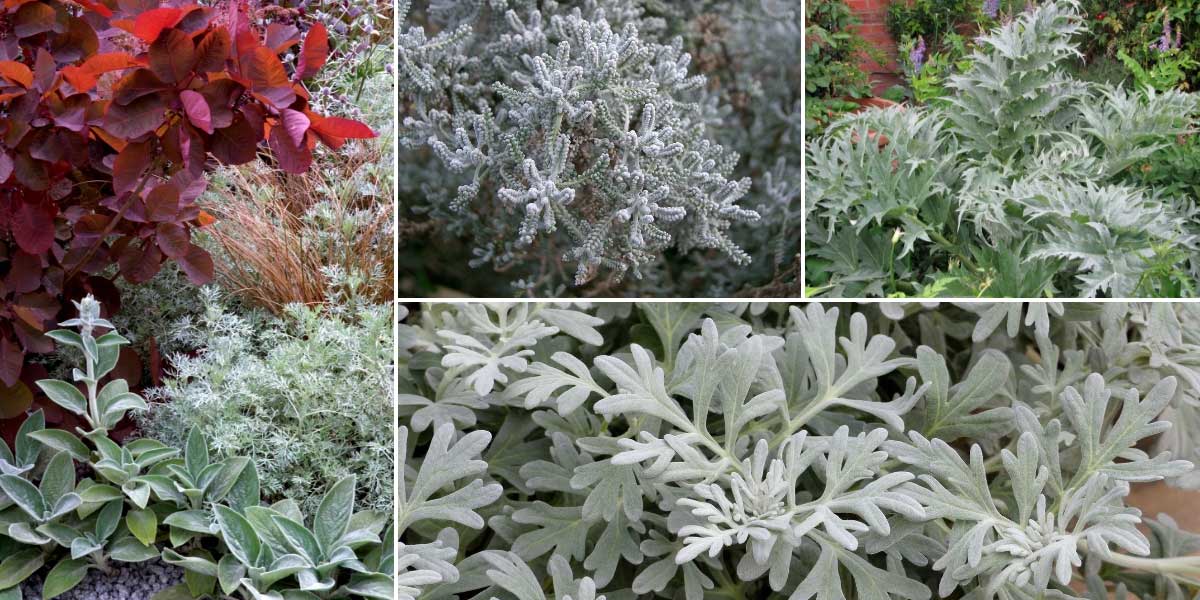
You can use artemisia to create a very original, silver-toned border, but we recommend integrating a few plants with dark foliage (deep red, black, brown) to add contrast. A combination with Cotinus ‘Grace’, Stachys byzantina and Artemisia ‘Powis Castle’ (photo Liz Eddison – Flora Press – Biosphoto) / Santolina chamaecyparissus (photo KENPEI) / Cynara cardunculus / Artemisia stelleriana ‘Silver Brocade’
Thanks to their many virtues, artemisia have an important place in medicinal and aromatic plant gardens. Choose tarragon (Artemisia dracunculus) or southernwood (Artemisia abrotanum), and plant them with sages, thyme, mullein, hyssop… Create a physic garden or cottage herb garden, combining useful plants with edible flowers and some vegetables.
Artemisia, with the soft silver tone of their foliage, are perfect in romantic gardens! We recommend pairing them with roses, peonies, bleeding hearts, Astrantia, hollyhocks… You can place a bush such as Weigelia in the background for beautiful pink flowering, or Deutzia for white or pinkish flowers. For a soft, gentle garden!
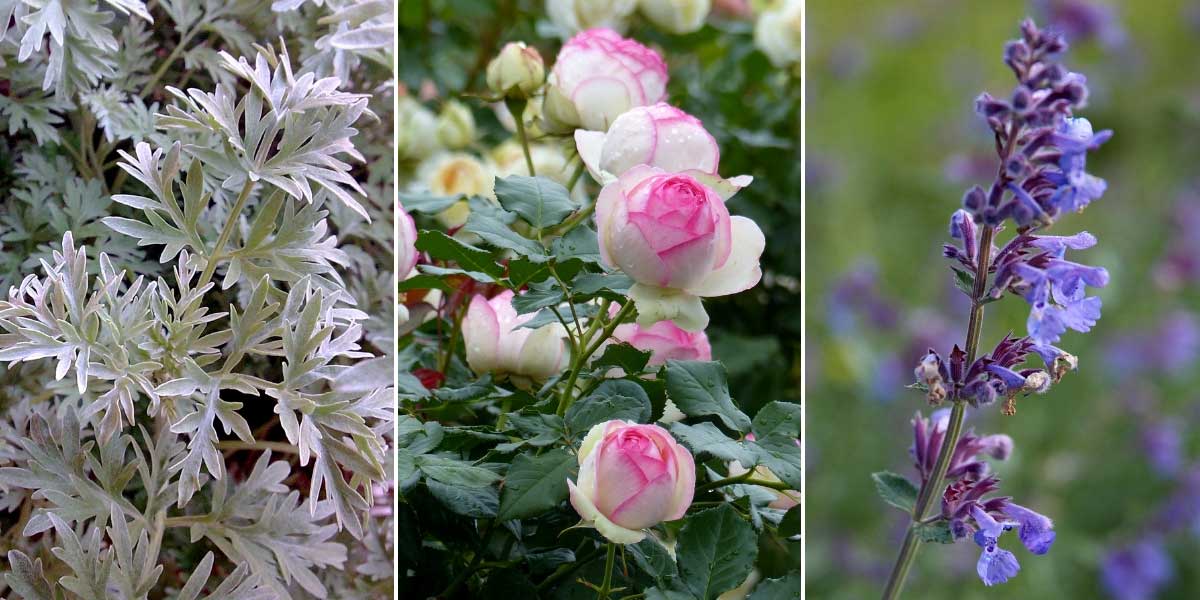
For a romantic atmosphere, plant artemisia at the base of roses together with nepeta or Astrantia. Artemisia absinthium (photo Epanto) / Climbing rose ‘Pierre de Ronsard’ / Nepeta faassenii
Artemisia also pair wonderfully with romantic, delicate shades: blue, mauve, soft pink, white. Choose pastel, very soft colours. You can plant roses, gypsophilas, hardy geraniums, perennial flax… Scatter some grasses in the border: Pennisetum or Lagurus ovatus, for lightness and softness of their flower spikes. Artemisia go particularly well with blue tones: plant them with nepeta, agastache, nigella, Scabiosa caucasica… Add pulmonarias, which have leaves marked with silvery spots and flower in blue, mauve or pink.
You can also, conversely, pair them with vivid shades such as red, orange or pink. The silvery colours of artemisia provide a beautiful backdrop that highlights other flowerings. For example, plant with dahlias, gaillardias, Lychnis coronaria or echinacea.
Artemisia also fit well in seaside gardens, notably Mediterranean gardens. Plant with lavender, Phlomis fruticosa, rosemary, olive trees, cistus, helianthemums… You can create a rockery by placing artemisia alongside plants that prefer stony, very free-draining and relatively dry soil.
→ Learn more with our advice sheet: Pairing artemisia
Did you know?
- Medicinal plant
Mugworts are good medicinal plants. The species most used for its properties is common mugwort, Artemisia vulgaris. It is tonic and fortifying, anthelmintic, antiseptic, effective against digestive problems; and it is also an emmenagogue: it promotes, induces and regulates menstruation. Artemisia annua is even believed to be effective against malaria!
Useful resources
- Discover our range of artemisia
- Our advice sheet: Choosing an artemisia
- Our advice sheet – How to create a beautiful perennial border?
- An article by Michael on our blog – How to fail at planting perennials in 6 lessons?
- An article by Virginie on Aromatic plants with remarkable foliage
- To pair artemisia, take inspiration from this mood: Silver-white garden, chic elegance!
- Our advice sheet: Choosing an artemisia
- Subscribe!
- Contents
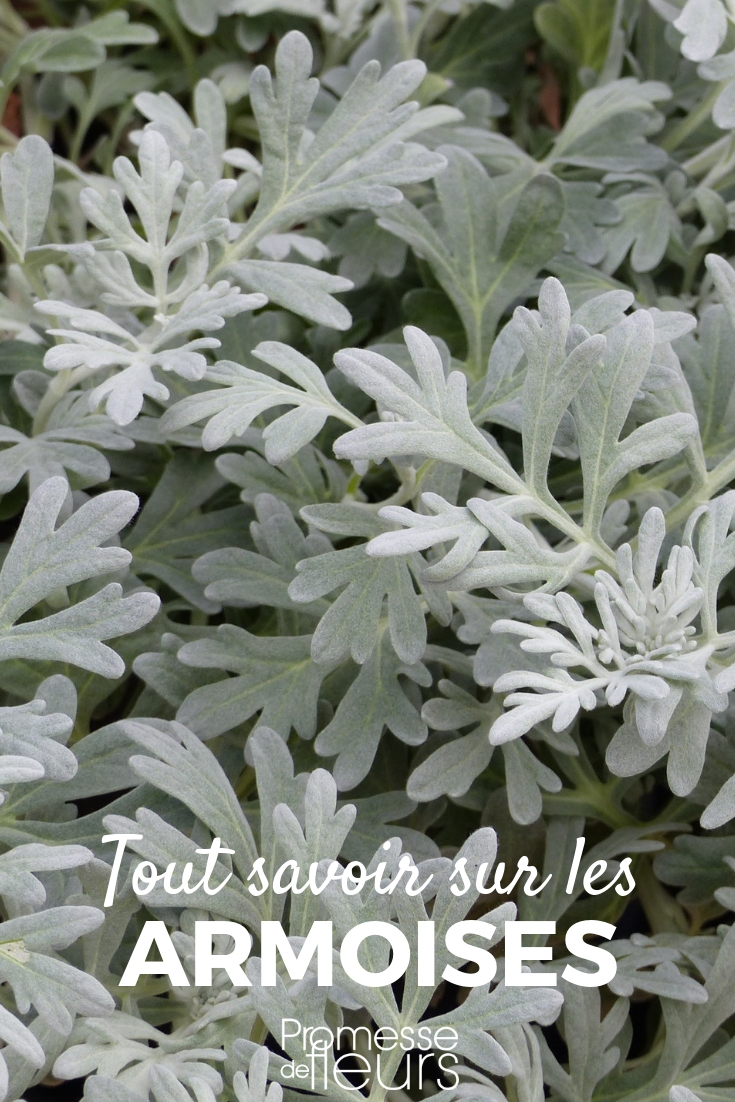































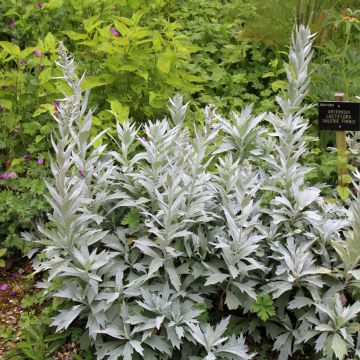



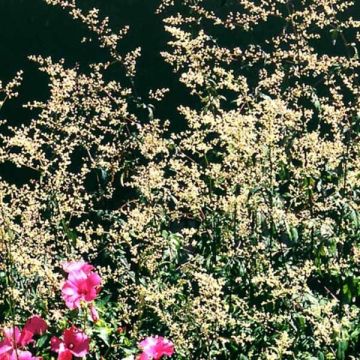
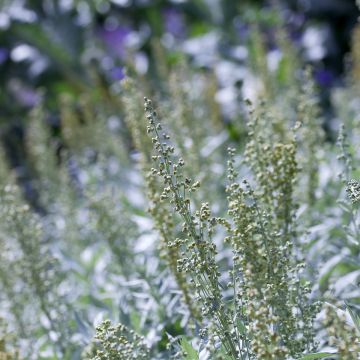
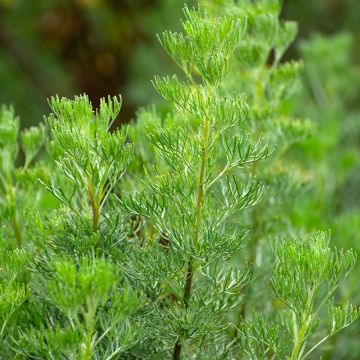



Comments